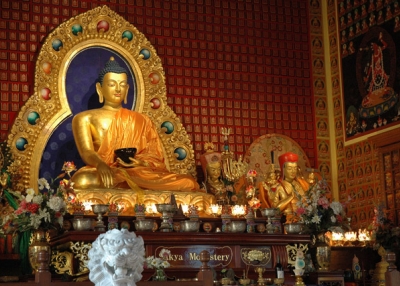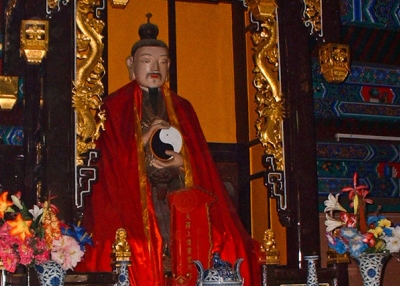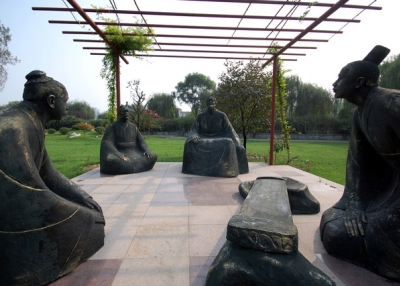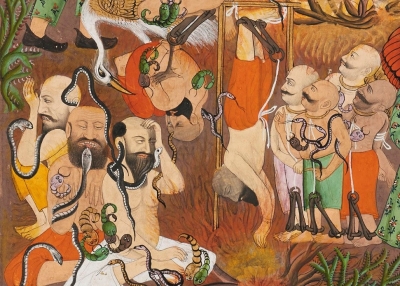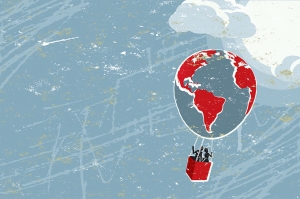Religion in the Philippines
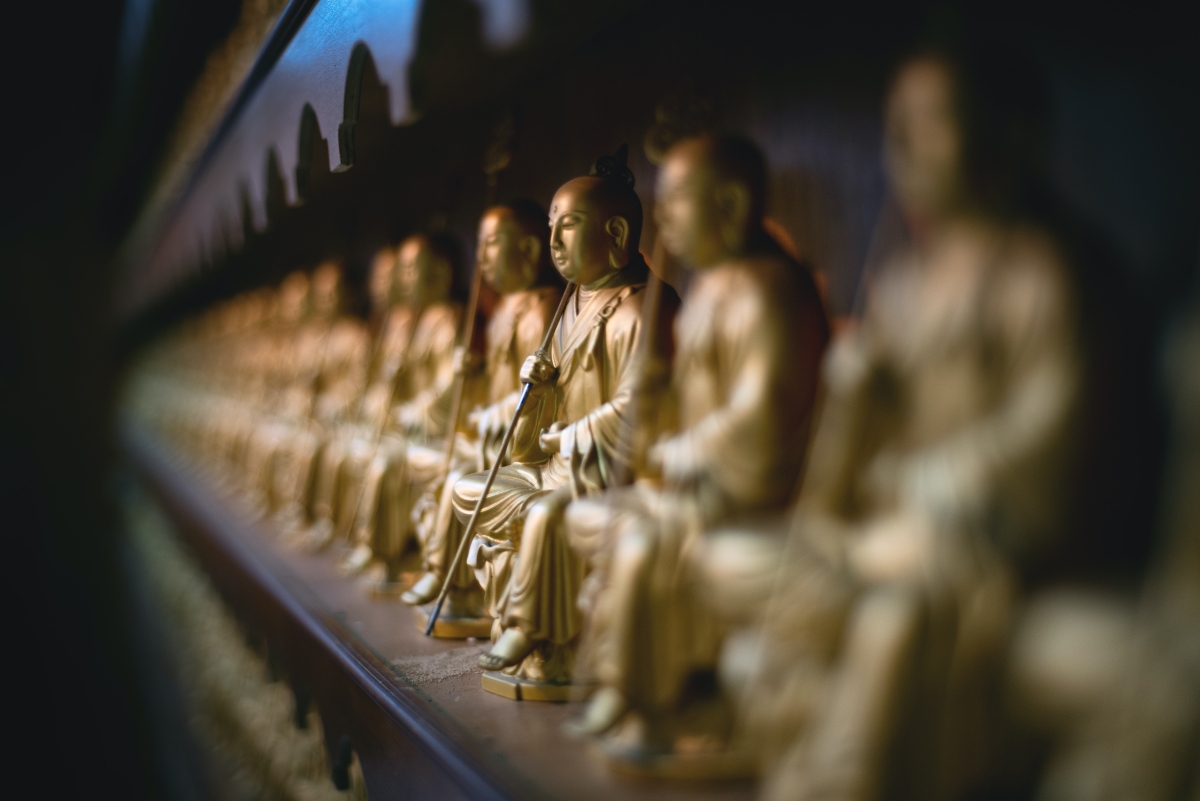
Gold Buddha statues, Fo Guang Shan Chu Un Temple, Cebu City, Philippines (Jopeel Quimpo/Unsplash)
by Jack Miller
The Philippines proudly boasts to be the only Christian nation in Asia. More than 86 percent of the population is Roman Catholic, 6 percent belong to various nationalized Christian cults, and another 2 percent belong to well over 100 Protestant denominations. In addition to the Christian majority, there is a vigorous 4 percent Muslim minority, concentrated on the southern islands of Mindanao, Sulu, and Palawan. Scattered in isolated mountainous regions, the remaining 2 percent follow non-Western, indigenous beliefs and practices. The Chinese minority, although statistically insignificant, has been culturally influential in coloring Filipino Catholicism with many of the beliefs and practices of Buddhism, Daoism, and Confucianism.
Asia Society in Manila
Learn More
The pre-Hispanic belief system of Filipinos consisted of a pantheon of gods, spirits, creatures, and men that guarded the streams, fields, trees, mountains, forests, and houses. Bathala, who created earth and man, was superior to these other gods and spirits. Regular sacrifices and prayers were offered to placate these deities and spirits--some of which were benevolent, some malevolent. Wood and metal images represented ancestral spirits, and no distinction was made between the spirits and their physical symbol. Reward or punishment after death was dependent upon behavior in this life.
Anyone who had reputed power over the supernatural and natural was automatically elevated to a position of prominence. Every village had its share of shamans and priests who competitively plied their talents and carried on ritual curing. Many gained renown for their ability to develop anting-anting, a charm guaranteed to make a person invincible in the face of human enemies. Other sorcerers concocted love potions or produced amulets that made their owners invisible.
Upon this indigenous religious base two foreign religions were introduced -- Islam and Christianity -- and a process of cultural adaptation and synthesis began that is still evolving. Spain introduced Christianity to the Philippines in 1565 with the arrival of Miguel Lopez de Legaspi. Earlier, beginning in 1350, Islam had been spreading northward from Indonesia into the Philippine archipelago. By the time the Spanish arrived in the 16th century, Islam was firmly established on Mindanao and Sulu and had outposts on Cebu and Luzon. At the time of the Spanish arrival, the Muslim areas had the highest and most politically integrated culture on the islands and, given more time, would probably have unified the entire archipelago. Carrying on their historical tradition of expelling the Jews and Moros [Moors] from Spain (a commitment to eliminating any non-Christians), Legaspi quickly dispersed the Muslims from Luzon and the Visayan islands and began the process of Christianization. Dominance over the Muslims on Mindanao and Sulu, however, was never achieved during three centuries of Spanish rule. During American rule in the first half of this century the Muslims were never totally pacified during the so-called "Moro Wars." Since independence, particularly in the last decade, there has been resistance by large segments of the Muslim population to national integration. Many feel, with just cause, that integration amounts to cultural and psychological genocide. For over 10 years the Moro National Liberation Front has been waging a war of secession against the Marcos government.
While Islam was contained in the southern islands, Spain conquered and converted the remainder of the islands to Hispanic Christianity. The Spanish seldom had to resort to military force to win over converts, instead the impressive display of pomp and circumstance, clerical garb, images, prayers, and liturgy attracted the rural populace. To protect the population from Muslim slave raiders, the people were resettled from isolated dispersed hamlets and brought "debajo de las companas" (under the bells), into Spanish organized pueblos. This set a pattern that is evident in modern Philippine Christian towns. These pueblos had both civil and ecclesiastical authority; the dominant power during the Spanish period was in the hands of the parish priest. The church, situated on a central plaza, became the locus of town life. Masses, confessions, baptisms, funerals, marriages punctuated the tedium of everyday routines. The church calendar set the pace and rhythm of daily life according to fiesta and liturgical seasons. Market places and cockfight pits sprang up near church walls. Gossip and goods were exchanged and villagers found "both restraint and release under the bells." The results of 400 years of Catholicism were mixed -- ranging from a deep theological understanding by the educated elite to a more superficial understanding by the rural and urban masses. The latter is commonly referred to as Filipino folk Christianity, combining a surface veneer of Christian monotheism and dogma with indigenous animism. It may manifest itself in farmers seeking religious blessings on the irrice seed before planting or in the placement of a bamboo cross at the comer of a rice field to prevent damage by insects. It may also take the form of a folk healer using Roman Catholic symbols and liturgy mixed with pre-Hispanic rituals.
When the United States took over the Philippines in the first half of the century, the justifications for colonizing were to Christianize and democratize. The feeling was that these goals could be achieved only through mass education (up until then education was reserved for a small elite). Most of the teachers who went to the Philippines were Protestants, many were even Protestant ministers. There was a strong prejudice among some of these teachers against Catholics. Since this Protestant group instituted and controlled the system of public education in the Philippines during the American colonial period, it exerted a strong influence. Subsequently the balance has shifted to reflect much stronger influence by the Catholic majority.
During the period of armed rebellion against Spain, a nationalized church was organized under Gregorio Aglipay, who was made "Spiritualhead of the Nation Under Arms." Spanish bishops were deposed and arrested, and church property was turned over to the Aglipayans. In the early part of the 20th century the numbers of Aglipayans peaked at 25 to 33 percent of the population. Today they have declined to about 5 percent and are associated with the Protestant Episcopal Church of the United States. Another dynamic nationalized Christian sect is the lglesia ni Kristo, begun around 1914 and founded by Felix Manolo Ysagun. Along with the Aglipayans and Iglesia ni Kristo, there have been a proliferation of Rizalist sects, claiming the martyred hero of Philippine nationalism, Jose B. Rizal as the second son of God and are incarnation of Christ. Leaders of these sects themselves often claim to be reincarnations of Rizal, Mary, or leaders of the revolution; claim that the apocalypse is at hand for non-believers; and claim that one can find salvation and heaven by joining the group. These groups range from the Colorums of the 1920s and 1930s to the sophisticated P.B.M.A. (Philippine Benevolent Missionary Association, headed by Ruben Ecleo). Most of those who follow these cults are the poor, dispossessed, and dislocated and feel alienated from the Catholic church.
The current challenge to the supremacy of the Catholic church comes from a variety of small sects -- from the fundamentalist Christian groups, such as Jehovah's Witnesses and Seventh Day Adventists, to the lglesia ni Kristo and Rizalists. The Roman Catholics suffer from a lack of personnel (the priest to people ratio is exceedingly low), putting them at a disadvantage in gaining and maintaining popular support. The Catholic church is seeking to meet this challenge by establishing an increasingly native clergy and by engaging in programs geared to social action and human rights among the rural and urban poor. In many cases this activity has led to friction between the church and the Marcos government, resulting in arrests of priests, nuns, and lay people on charges of subversion. In the "war for souls" this may be a necessary sacrifice. At present the largest growing religious sector falls within the province of these smaller, grass roots sects; but only time will tell where the percentages will finally rest.
For Further Reference
Agoncillo, Teodoro.A Short History of the Philippines. New York: Mentor Books, 1969.
Carroll, John J., and others.Philippine Institutions. Manila: Solidaridad, 1970.
Chaffee, Frederic H., and others. Area Handbook for the Philippines. Washington, D.C.: Government Printing Office, 1969.
Corpuz, Onofre D. The Philippines. Englewood Cliffs, NJ: Prentice Hall; Spectrum Books, paper, 1965.
Gowing, Peter G., and Robert D. McArnis, eds. The Muslim Filipinos. Manila: Solidaridad, 1974.
Mercado, Leonardo N., ed. Filipino Religious Psychology. Tacloban City, Philippines: Divine Word University, 1977.
Ramos, Maximo D. Creatures of Philippine Lower Mythology. Quezon City, Philippines: University of the Philippines Press, 1971.
Sturtevant, David R. Popular Uprisings in the-Philippines, 1840-1940. Ithaca: Cornell University Press, 1976.
Discover Asia
Thank You for Reading!
If you’d like to support creating more resources like this please consider donating or becoming a member.

